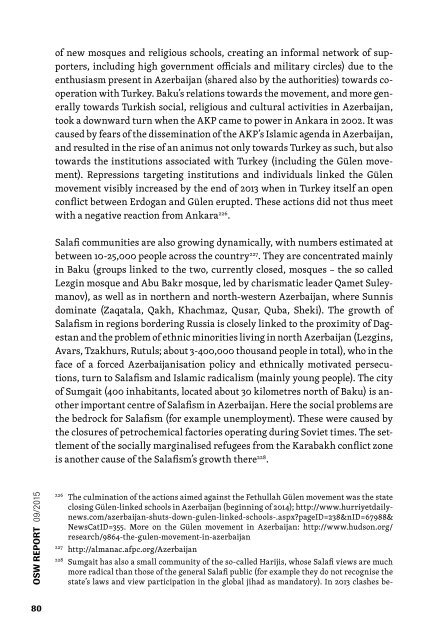HOMO JIHADICUS
homojihadicus
homojihadicus
You also want an ePaper? Increase the reach of your titles
YUMPU automatically turns print PDFs into web optimized ePapers that Google loves.
of new mosques and religious schools, creating an informal network of supporters,<br />
including high government officials and military circles) due to the<br />
enthusiasm present in Azerbaijan (shared also by the authorities) towards cooperation<br />
with Turkey. Baku’s relations towards the movement, and more generally<br />
towards Turkish social, religious and cultural activities in Azerbaijan,<br />
took a downward turn when the AKP came to power in Ankara in 2002. It was<br />
caused by fears of the dissemination of the AKP’s Islamic agenda in Azerbaijan,<br />
and resulted in the rise of an animus not only towards Turkey as such, but also<br />
towards the institutions associated with Turkey (including the Gülen movement).<br />
Repressions targeting institutions and individuals linked the Gülen<br />
movement visibly increased by the end of 2013 when in Turkey itself an open<br />
conflict between Erdogan and Gülen erupted. These actions did not thus meet<br />
with a negative reaction from Ankara 226 .<br />
Salafi communities are also growing dynamically, with numbers estimated at<br />
between 10-25,000 people across the country 227 . They are concentrated mainly<br />
in Baku (groups linked to the two, currently closed, mosques – the so called<br />
Lezgin mosque and Abu Bakr mosque, led by charismatic leader Qamet Suleymanov),<br />
as well as in northern and north-western Azerbaijan, where Sunnis<br />
dominate (Zaqatala, Qakh, Khachmaz, Qusar, Quba, Sheki). The growth of<br />
Salafism in regions bordering Russia is closely linked to the proximity of Dagestan<br />
and the problem of ethnic minorities living in north Azerbaijan (Lezgins,<br />
Avars, Tzakhurs, Rutuls; about 3-400,000 thousand people in total), who in the<br />
face of a forced Azerbaijanisation policy and ethnically motivated persecutions,<br />
turn to Salafism and Islamic radicalism (mainly young people). The city<br />
of Sumgait (400 inhabitants, located about 30 kilometres north of Baku) is another<br />
important centre of Salafism in Azerbaijan. Here the social problems are<br />
the bedrock for Salafism (for example unemployment). These were caused by<br />
the closures of petrochemical factories operating during Soviet times. The settlement<br />
of the socially marginalised refugees from the Karabakh conflict zone<br />
is another cause of the Salafism’s growth there 228 .<br />
PRACE OSW REPORT OSW 09/2012 09/2015<br />
226<br />
The culmination of the actions aimed against the Fethullah Gülen movement was the state<br />
closing Gülen-linked schools in Azerbaijan (beginning of 2014); http://www.hurriyetdailynews.com/azerbaijan-shuts-down-gulen-linked-schools-.aspx?pageID=238&nID=67988&<br />
NewsCatID=355. More on the Gülen movement in Azerbaijan: http://www.hudson.org/<br />
research/9864-the-gulen-movement-in-azerbaijan<br />
227<br />
http://almanac.afpc.org/Azerbaijan<br />
228<br />
Sumgait has also a small community of the so-called Harijis, whose Salafi views are much<br />
more radical than those of the general Salafi public (for example they do not recognise the<br />
state’s laws and view participation in the global jihad as mandatory). In 2013 clashes be-<br />
80


